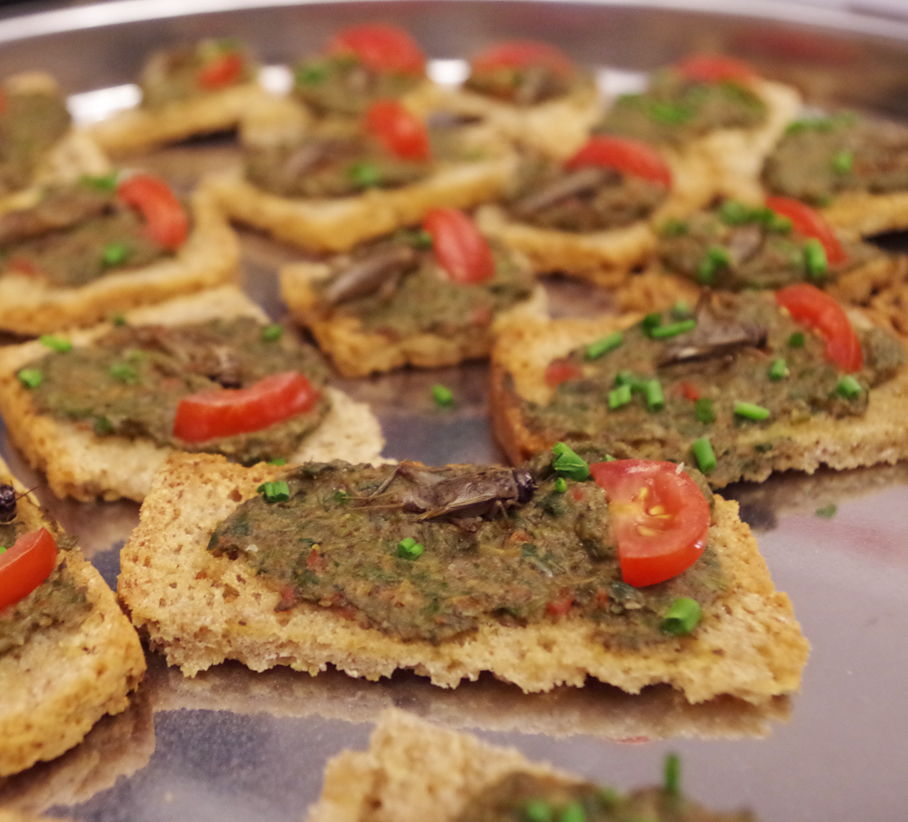

The Future Food Salon describes itself as “a celebration of food in an arts-soaked setting that explores with enthusiasm what we will be eating in the future.” This is not untrue! But it would be perhaps more descriptive to say the Future Food Salon is like a book reading at which you eat bugs. Lots of bugs.
I headed out to the far west side of Manhattan yesterday evening, to one of the many airy, modern, vaguely industrial event spaces that seem to be all there is between 18th and 34th Streets, west of 10th Avenue. Given that I don’t think anyone can actually live out there, I think I’ve spent about as much time as anyone in that part of town; in addition to art galleries, it’s where tech companies introduce and demo new gadgets, and, I guess, it’s where you’d go to see Andrew W.K. get zapped with a million volts of electricity. But yesterday I was going to eat bugs, not play with new cellphones.
The event was cheerful and moderately drunk; the bartender was pouring, like, completely full-to-the-brim glasses of wine, possibly to counter any trepidation the guests had about eating toffee that was intentionally covered with bugs. The hosts were a mixture of Future Food Salon people (enthusiastic Torontonians) and do-gooders interested in promoting sustainable bug-eating (mostly from Austin, Texas), and the guests were a nice mix of journalists, photographers, NYU students who had come out to see the panels that preceded the tasting, and a few excessively stylish people who looked like they’d wandered in off the street and might be heading to eight or nine gallery openings after this. I was there for the bugs.
The eating of insects as food is called, sort of clinically and unappetizingly, “entomophagy.” It’s not unusual outside of North American and Western Europe; in Mexico, for instance, chapulines, or grasshoppers, are a favorite bar snack and taco filling. But here, eating bugs is pretty much limited to reality TV shows.
That could change, as we’re looking at a near-inevitable food crisis brought on by factory farming. Factory farm animals, like cows, pigs, and chickens, consume massive amounts of grain, water and land, and require the deforestation of huge swathes of the planet. A 2009 study estimated that factory livestock is responsible for 50 percent of the world’s man-made greenhouse gases. It’s no surprise, then, that scientists and others have been looking to alternatives, from lab-grown meat to, well, bugs.

Entomophagy has a lot going for it. Bugs are high in protein, so they’re a good replacement for mammal or bird meat. They eat less food, reduce our need for pesticides (because, um, that would kind of defeat the point), and contribute minimal greenhouse gases. Many types of insects (like mealworms) don’t even require water, since they get enough from their food. Insects are also easy to raise at home, and don’t take up much space. At the Future Food Salon, I was shown a mockup of an in-house cricket enclosure, designed to be placed on your counter next to your microwave and toaster oven (pictured above). It worked pretty much like a tiny chicken coop–a cricket coop, you might say. Click through to the gallery for a seven-item hors d’oeuvres spin through the wonders of bug-eating.







